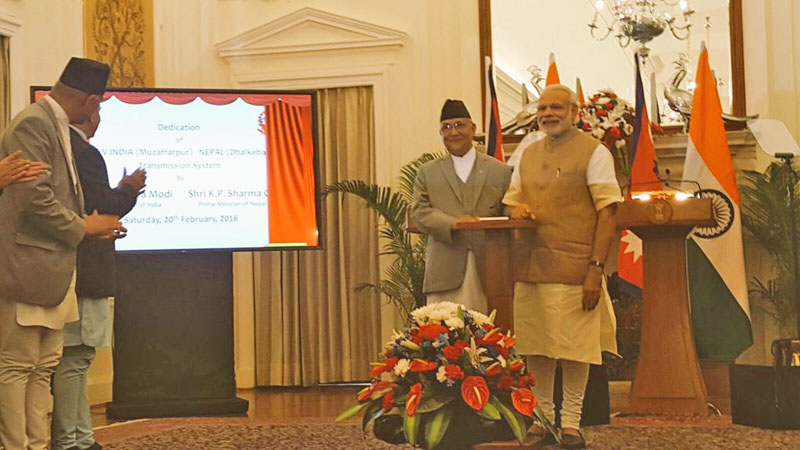Nepal, India sign crucial agreements
Kathmandu, February 20
Nepal and India, today, signed four crucial letters of exchange (LoEs) related with trade and transit, which are expected to create a momentum in the economic development of the country through enhancement of the trade sector.
Officials of India and Nepal have signed the long-stalled LoEs on trade and transit on behalf of their respective governments in the presence of Prime Minister KP Sharma Oli and his Indian counterpart Narendra Modi during PM Oli’s visit to India.
The southern neighbour has agreed to provide transit facilities for Nepal through the Visakhapatnam port along with the signing of LoE called ‘Operationalisation of Visakhapatnam Port’. Henceforth, Nepal will be able to use Visakhapatnam Port as another gateway for third-country trade like the Kolkata Port.
Till date, the southern neighbour has been allowing the use of Kolkata Port to import goods from third countries.
The government of India had principally agreed to allow Nepal-bound cargoes to use Visakhapatnam Port in August of 2009 during then prime minister Madhav Kumar Nepal’s visit to India, which has been realised after six years.
Two critical LoEs related to rail transport — ‘Rail Transport To and From Visakhapatnam to Nepal’ and ‘Rail Transit Facility Through Singabad for Nepal’s Trade With and Through Bangladesh’ — were also signed during the prime minister’s visit to India. The Indian government will extend rail transport facility for the Nepal-bound cargoes from Visakhapatnam Port and vice versa under the provision of ‘Rail Transport To and From Visakhapatnam to Nepal’.
Similarly, LoE on ‘Rail Transit Facility Through Singabad for Nepal’s Trade With and Through Bangladesh’ will help operationalise rail transit facility through Singabad in India for Nepal’s trade with and through Bangladesh. Along with the agreement, the traffic in transit to and from Nepal and Bangladesh shall move through Indian territory by rail using Singabad Railway Station (West Bengal, India) and Rohanpur Railway Station in Bangladesh.
Apart from this, the southern neighbour also agreed to ensure the seamless movement of vehicles between Kakadvitta of Nepal to Banglabandha corridor of Bangladesh. The LoE ‘Transit Between Nepal and Bangladesh Through Kakadvitta-Banglabandha Corridor’ signed between India and Nepal would result in simplification of modalities for traffic of goods between Nepal and Bangladesh while transiting through India. Nepal and Bangladesh use Indian territory of over 52 km to and from Kakadvitta (Nepali border) to Banglabandha (inland port in northern Bangladesh). Currently, Indian government allows only a limited number of vehicles loaded with cargoes through this route citing security concerns.
After the signing ceremony of the crucial agreements, Indian Prime Minister Narendra Modi said that the opening of the two additional transit points would have a huge impact in regional development and connectivity. The Indian Prime Minister also pledged for the early construction of the Integrated Check Posts (ICPs) at the border points. Construction works of ICPs in Birgunj, Biratnagar and Bhairahawa have been initiated in cooperation with the Indian government.
Till now, there has been no substantive progress in the development of ICPs in Nepal side except in Birgunj. Over 80 per cent of the work of the ICP Birgunj has been completed so far. However, ICPs in the Indian side at the bordering points of all three towns have already been completed.
Dhalkebar-Muzaffarpur cross-border transmission line inaugurated
KATHMANDU: Prime Minister KP Sharma Oli and his Indian counterpart Narendra Modi on Saturday jointly inaugurated
the Dhalkebar-Muzaffarpur cross-border transmission line using a remote controlled switch from Hyderabad House of New Delhi. The Nepal portion of the 400kV Dhalkebar-Muzaffarpur transmission line was implemented by the Nepal government, utilising the line of credit (LoC) facility worth $13.5 million extended by the Indian government. With the official launch of the transmission line, initially charged at 132kV, India exported 80MW of electricity to Nepal.
The government of India will increase the load to 200MW in October this year, when the line will be charged at 220kV. Moreover, the country will be able to import 600MW of electricity by December 2017, when the line will be fully charged at 400kV. — HNS






